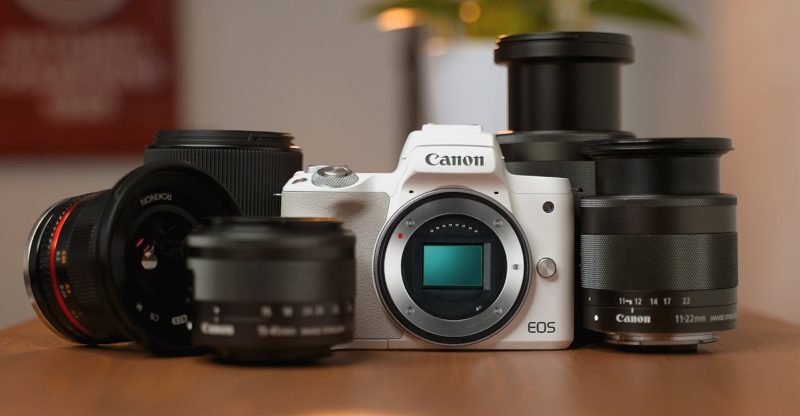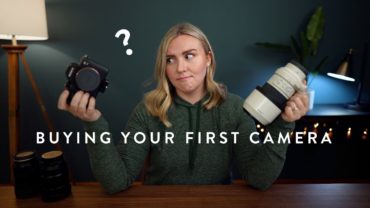BEST Lenses for Canon M50 II (Ultimate Buyers Guide For Video and Photography)
– One of the best features
about the Canon M50 Mark II is the fact that it has
interchangeable lenses. However, you don't need every lens that is offered on the market. That's why in this lens buying guide for the Canon M50 Mark II I'll be breaking down all the lenses and the best use cases, so that whatever content
that you are creating you can get the right lens for you. Let's go. You gotta just press record. Hey, what's up. it's Omar
El-takrori with Think Media, helping you build your
influence with online video. Based off of anything I say in this video, make sure you check out the
description to see special links to all the various lenses, the
brands and things like that that I will be talking about. Now in regards to the
way I'm gonna break down this buyer's guide when it comes to lenses
for the Canon M50 Mark II, I'm gonna be breaking it
down first by native lenses like the EFM Mount, the
lenses that Canon offers and then we're gonna move into Sigma and we're gonna
talk about some budget options, and then we'll finish out with adapters, which is one of my favorite
ways to actually expand the M50 Mark II.
And this also applies for
any EF-M Mount camera. So if you have an M50
Mark I, and M200, and M6, or M6 <Mark II, these lenses
would apply to you as well. Now the first native Canon EF-M Mount lens I wanna talk about is the actual kit lens that you could purchase
when you buy the Canon M50. Now the kit lens that comes
with the Canon 50 Mark II is the 15 to 45 millimeter lens.
This is a great universal
lens because at 15 millimeters it's gonna be a nice focal length if you want to start blogging, or if you wanna do talking
head videos for YouTube, or what have you. But just to know that 15
millimeters is a good focal length. It's kind of like medium
wide, I would say. And so one thing about
the kit lens however, is that it starts at 3.5 when
it comes to the aperture.
And then as you zoom into 45 millimeters you're going to be at
6.3 in your aperture. And so it's not a constant aperture lens. However, one cool feature
is that it does have image stabilization in the
lens itself, which is awesome. And so when you pair up the
digital image stabilization from the camera you're gonna
get a nice, smooth image removing any jitters, if you're
blogging or what have you. The next lens is just
a quick notable mention 'cause it's very similar to the kit lens, but that is the 18 to 55 millimeter lens. Just wanted to throw it on the radar. I still would go with the 15 to 45 just because the chances
are, is you're gonna be using your M50 to film yourself
or what have you. And so the next lens I wanted to bring up is probably the best lens if
you're going to be vlogging with your Canon M50, and that is the 11 to 22 millimeter lens.
This lens will give you
that super wide vlog look, and even if you're not vlogging, but you're filming yourself,
you know, in your studio, or what have you, having a
super wide lens can actually make your space look a lot
bigger than it actually is. And so if even find yourself
filming in tight spaces in places a lens like this would be great. Another reason why I
love super wide lenses is because your audio will improve as you bring your camera
closer to your face.
If you have a mic right on top of your M50 and you have a wide lens,
you're gonna get good audio 'cause you'll just naturally
get closer to the camera. So that's just something to think about. If you plan on vlogging with the Canon M50 look into this lens, it's
definitely worth getting. And what's also cool is
it also does have image stabilization on it. So you really have the perfect setup when it comes to vlogging with this lens. The next two lenses I want to talk about are on the more
versatile side when it comes to being able to zoom in a lot.
And so if you're really far away or if you want to do landscape photography this is something you
wanna look into maybe. And the first one is the
18 to 150 millimeter. Yes, all the way from 18
millimeter zoomed out, which is a nice medium wide shot. Maybe a little bit tight if you're gonna try and blog with that. But as far as zooming all the way into 150 you're gonna be able to focus on a subject that's pretty far, which is nice. And so all that compression although it is a variable
aperture lens from 3.5 to 5.6 it'll still be okay if
you have good lighting. The other lens is a
little bit more of a zoom and it starts at 55 millimeters and it goes all the
way to 200 millimeters.
So if you're really trying to
get into landscape photography or whatever content you're creating will require you to zoom in a lot. The 18 to 150 comes in at $500 and the 55 to 200 comes in at $349. And these are all retail prices at the time of shooting this video. So the five Canon lenses
that I just mentioned all give you the ability to
zoom in and out at some level. You're gonna get multiple
focal links with those lenses, but they all have a variable aperture. Now if you really want that
super blurry background you're gonna want a low aperture lens. And so the next portion of
the Canon EF-M native mounts are the prime lens options. And the first one I wanna talk about is the 22 millimeter lens.
This is a very popular lens. They call it the pancake lens. All these primes that I'm going to talk about are pretty small lenses. But this is at F2. And so being at F2 will really give you that nice blurry background. And if you don't have a ton of light that's gonna be okay. You can still stay at lower apertures. But I think a lot of people
just want a blurry background. I think the only downside to
this prime lens is that F22 on the M50 is a little bit tight if you're gonna vlog with it. So this wouldn't be a lens that
you would use to blog with. I would consider a lens like
this to be a talking head lens as it gives you about a medium shot.
Just know that this lens is not the best for arms length distance,
but it is an option and it is a great lens that
you can pick up as well. The next prime lens I wanna talk about is the 28 millimeter lens. And so you're getting a little
bit more of a tighter shot as it is a macro lens. It'll allow you to get really,
really close to objects. So if you are shooting weddings, or you need to get detailed
shots of really tight things or you shoot maybe nature
and you wanna shoot a bee or something on a
flower, oh, I don't know, those are kind of the use
cases of a macro lens. And so it is a prime lens at
3.5, but that 3.5 up close to an object will really
give you that nice bokeh, or bokeh as people would say,
what is it in the comments? Let me know what it is. Is it bokeh or is it bokeh? I don't know. Either way this is a macro lens. So you wanna buy this if you're doing close-up food photography, weddings, things like that, detailed shots.
And then the last prime
lens that Canon offers in their EF-M lineup is a
32 millimeter lens, 1.4. And this lens comes in at
around $480, kind of pricey, but this would be a great
portrait lens for your Canon M50 if you plan on doing
photography, headshots and things like that,
'because the 32 millimeter will be kind of close to a 50 millimeter. But I do wanna talk about
how you can achieve that look for a third or a quarter of that price, but I'll say that toward
the end of this video. This next portion though,
I do wanna talk about, is the Sigma line of lens up. And they have three
lenses that they offer. And the first is, I would
consider the YouTube lens with the Sigma 16 millimeter 1.4 lens.

And this lens is, I think my favorite lens for the Canon M50 when
it comes to creating YouTube videos on. It's a $400 lens at the
time of shooting this video. It has some nice weight to it, but the focal length of 16
millimeters is kind of equivalent to about 24 millimeters. And so if you're shooting
at arms like distance, or about double arms length distance, or you're live-streaming
from that far of your camera, this is gonna be an incredible
lens because that aperture. That aperture at 1.4 will give you that
super blurry background, or even if you keep it at F2,
or it's just the focal length mixed with how low that aperture is, I'll just give you the
look you're probably looking for if you wanna shoot
talking head YouTube videos from about arms to two
arms length distance from your camera. And so they have included two other lenses and I would gear these lenses
toward photography use. And the first one is a 30 millimeter lens and that comes in at $290 at the time of shooting this video.
This would be a great lens
for your general photography if you're doing portraits, or if you're doing family photo
shoots and things like that. This is gonna be a good focal length as it'll probably be around
a 45 or so focal length when shooting on a crop sensor camera. Now the third lens that Sigma has created is a 56 millimeter 1.4 lens. This is a lens equivalent to
about an 85 millimeter lens, which if you do photography
I wouldn't think you need all that many lenses, but the
85 millimeter lens in general is just a great lens for compression.
So if you really are trying to
get a nice tight crispy shot, it's gonna be a great lens for you. And all of Sigma's lenses
do really really well on the E-FM cameras that Canon offers. And so those are the three
lenses, the Sigma 16 though. I mean, we had got a couple
of those around Think Media, because it really is,
just a really good lens. And I think if you're trying
to take YouTube seriously that might be the lens for you. So we've covered a lot of lenses, but there's still a lot more
I want to put on your radar, but if you're getting value in this video let me know by hitting that
like button, thank you so much. And question for you is, what
do you use your Canon for? I think because it has a flip out screen, because it has so many features you can use this for
live-streaming, for vlogging, for YouTube videos and things like that.
But let me know down in the comments, would love to know what kind
of content you are using. But the next portion of this video I wanna talk about real
quick are the budget lenses that are offered for the Canon EF-M Mount. So if you haven't picked
up on the idea already it really is the lens that
creates the look you want in the videos or the photos you take with your Canon M50 mark II. And so with that being
said sometimes you may want auto-focus for the type
of stuff you are creating, sometimes you can deal with manual focus, because you're locking in your shot, you're not going to be moving.
And so with that being said,
you can save some money. And so the first lens I wanna
talk about is the Neewer 25 millimeter 1.8 lens. That's only $70. For only $70 you're gonna
get a super crispy shot because of that aperture. However, it is a manual focusing lens. And so if you are doing
live-streams and stuff like that, it might be good 'cause
you're not gonna be moving from your desk. Or if you're shooting talking head video, you can lock in the shot if
you put something in place of where you'll sit or stand, but 70 bucks, you can't really beat it. Neewer also makes a 35 millimeter 1.7 for around $70 as well. Also a manual focus lens, but that's going to give you
even more of a tighter shot closer to that, you know,
50 millimeters or so.
The next one is the, I don't
even know how to pronounce it. It's like Meike, or Meike, or Meeike. It's a 50 millimeter prime lens at F2, and it comes in at around
$75, which is awesome, but it's also a manual focusing lens. But this is a great lens
if you are doing photos and you can actually zoom
in digitally on your M50 to make sure that you are
getting yourself in focus, or getting your subject in focus. And also you can use focus
peaking to actually ensure that. You can get by with manual focus lenses and you can get by with a budget, right? If you are on a budget and you
want that blurry background this would be the way
to go with these lenses. The next lens is a Viltrox
23 millimeter 1.4 lens that comes in at around $279. And that is because it
is an auto-focus lens. But having the auto-focus ability is nice. The last lens I wanna bring
up in regards to other brands that could be found on Amazon
is the Rokinon 12 millimeter F2 lens that comes in at around $330.
And this is a manual focus lens. So I would say this is on
the pricier side for a lens that is manual. But I know what they're trying to do, you know, they're the only lens this wide for the Canon M50 with that aperture. So there isn't an
auto-focus lens available at that white of an aperture, but I think a lens like
this would be great if you're doing gimbal
work with the Canon 50. So if you're doing real
estate and stuff like that. Now the next portion of this, I think it's just an honorable mention, and it also lends itself
to my favorite use of this Canon M50 Mark II
for the use of photography. But that is to look into adapters.
The first adapter is
the Canon EOS M adapter, and that'll just take your Canon M50 and allow it to be used
with the EF world of lenses. There are some budget
options when it comes to this kind of adapter. Viltrox makes an adapter,
Calm Light makes an adapter, Mcoplus makes an adapter. And all these adapters are
very similar to the Canon-1, and they all come in at right
under $40, which is awesome. However, my favorite adaptor
for the Canon M50 line, or the EF-M line of lenses is the Viltrox speed booster adapter. And what I love about this adapter is it turns your Canon M50 essentially generally speaking, technically not, but it turns it into a full frame camera, because there's this
glass that's in the middle of the adapter that'll open up your lenses to full frame options.
And now you can use Canon EF lenses on this adapter and
shoot kind of full frame. And so I love the setup for photography if you're using a 50
millimeter, 1.8, you know, nifty fifty lens with this Viltrox adapter you're getting the full
50 millimeters out of it. And it also makes your
lenses a little bit faster by being able to bump down
your aperture a few stops. Now that might be a lot in a mouthful. We break it down in a video and you can check that
out in the description, we'll post links to it. But I think it's just key
to have it in your kit if you have the Canon
M50, I think at a minimum, if you're shooting thumbnails
and stuff the nifty fifty and the Viltrox adapter is a great setup. And also if you like taking photos of your family and stuff like that. And so with that being said
that covers the extensive lens buying guide for your Canon M50 Mark II, or EF-M Mount camera.
If you have a Canon
mirrorless crop sensor camera all this could apply to your camera. Let me know down in the comments below what lens really kind
of tickled your fancy. Is that weird to say, which lens really caught your attention? I definitely got to say
the Sigma 16 millimeter is one of my faves, and
then that Viltrox adapter with the nifty fifty, one of my faves. And if you wanna check out our playlists on the Canon M50 Mark
II make sure you click or tap the screen, or if you
wanna check out another video from Think Media you can
click or tap the screen. I can't wait to see you
in a future one, piece. (upbeat music).













